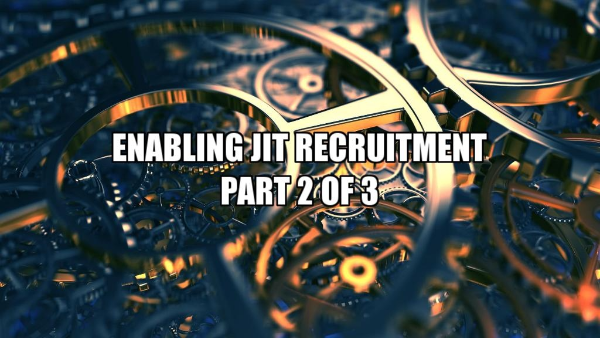
The End of Requisitions
February 28, 2018
5 Transferable Sales Techniques
April 3, 2018When establishing a JIT recruiting model, it’s important to select an organizational model and team structure best matching the opportunities and challenges of the JIT model.
Centralized Versus Decentralized:
There are essentially two organizational models for recruitment; centralized and decentralized. In centralized models, the bulk, if not all, of the recruiting team, reports to a corporate level executive or manager.
- Centralized refers less to the location of the recruiting team than to the fact it reports up to one HR executive, who broadly oversees the recruiting budget, directs both strategic and tactical skills and program planning, and determines individual/team assignments.
- Decentralized, on the other hand, refers to a team that is broken out to support specific locations and/or businesses, with recruiting resources typically reporting to divisional HR executives, or the GMs of the businesses they support.
In general, a centralized team will produce economy of scale and flexibility benefits, while a decentralized team will deliver value a higher level of customer connectivity and point-of-contact service.
What’s right for JIT?
There are a handful of specific capabilities an organization must have, in order to successfully deploy JIT recruiting. Here, we review those capabilities, and identify which functional model is best matched to each capability.
1. They must have exceptional candidate research and identification capabilities.
JIT recruiting requires a continuous infusion of new candidate and referral prospects, so the ability to proactively identify and contact candidates possessing the skills and abilities in high demand by the organization is critical.
Regardless of whether candidate research and identification is performed using internal or external resources, it’s critical the effort be as proactive and aggressive as possible, especially when mapping organizations of both direct and one-off competitors for high demand talent.
Advantage: Centralized
2. They must be prepared to gather and maintain detailed information on candidates working in high demand skill and ability areas.
JIT recruiting requires a high degree of touch with candidates possessing the skills, abilities, and personal attributes generally desired by the enterprise; its core requirements for specific high, or recurring demand job families. Once such a candidate is located, they either become an active candidate for current requirements, or a candidate for future requirements, based on the change triggers specific to the case. A high quality, user-friendly Applicant Tracking System is a must.
Candidate change triggers are events impacting a candidate’s opportunity and/or interest in making a change. Examples include stock or bonus vesting events, achievement of right to work status, completion of degrees or educational programs; anything improving the candidate’s ability to change companies.
Advantage: Centralized
3. They must maintain a high degree of connectivity with hiring authorities and their businesses.
JIT recruiters must have close, consistent contact with all the hiring leaders working in their assigned area(s) of need, as it’s important they be able to both screen candidates for position-specific requirements, while also being able to present selling points or change triggers regarding any specific business and/or program within the enterprise.
Examples of change triggers on the employer side include the pursuit of a new solution architecture, the hire of a dynamic industry figure, a major customer win, a commitment to increase R&D spending; essentially, anything that can be viewed as a sign of improved prospects for the company that would trigger increased interest by candidates. For more Information: Your Hiring Managers; the value of converting Customers to Partners
Advantage: Decentralized
4. They must have streamlined, standardized administrative processes.
Interview scheduling, compensation analysis and internal negotiation, offer review and approval; all administrative processes that must be completed prior to the extension of an offer must be designed for real-time turnaround.
Advantage: Neutral (assuming no variances across the organization)
5. They must excel in the solicitation of employee and partner referrals.
In a JIT recruiting enterprise, every member of the organization must be willing and able to become talent scouts. Programs and policies encouraging this behavior are a must, as is the high frequency communication of the organization’s talent needs.
Advantage: Centralized
6. They must be able to allocate recruiting resources where needed, as needed.
In a decentralized organization, recruiting assets will often encounter feast or famine workloads, since there’s no easy path to balancing workloads among recruiters supporting different divisions or business units.
With a centralized organization, recruiting management can shift resources within and between core skills teams, enabling effective responses to both peaks and valleys in demand loads.
This kind of cross-pollination also enables members of the recruiting team to learn different methods and techniques specific to recruiting candidates for positions they may not typically support.
Advantage: Centralized
7. They must be willing to service all requirements without favoritism.
JIT recruiting requires team members to not play favorites when it comes to the introduction and pursuit of candidates for one part of the organization over others. A decentralized recruiting team will, almost by definition, seek to place candidates in “their” open positions, rather than where the greater organization needs them.
Advantage: Centralized
Given the requirement set presented, a centralized organizational model is clearly a better match for a JIT recruiting deployment, as it enables enterprise-wide clustering of skills requirements, and all related recruiting assignments, while limiting the potential for conflicts between recruiters supporting hiring executives from different parts of the enterprise.
All other things being equal, organizations deploying JIT recruiting programs will typically achieve higher levels of efficiency and overall fill performance from a centralized organizational model.
Talent Acquisition and Talent Management…the not-so-secret JIT weapons
Organizationally, Talent Acquisition is an absolute requirement for a JIT recruiting enterprise. Without the ability to strategically identify and develop new sources for candidates with critical skills and abilities, the JIT enterprise will always be running the risk of overmining a capped candidate pool.
In the same way, Talent Management (formerly known as Training and Development) is an extremely powerful tool for JIT employers with the need to grow their own candidates with critical skills and abilities, where few or none may exist.
Talent Acquisition, when partnered with Talent Management, produces the ability to identify, engage, and develop candidates possessing some, but not all desired skills and abilities; converting them to high value candidates for critical roles.
The marriage of Talent Acquisition and Talent Management is critical not only to the development of candidates coming from outside the enterprise; it’s an absolute must for any enterprise wishing to efficiently re-task top performing employees whose jobs are in danger of elimination or relocation.
While both Talent Acquisition and Talent Management teams can function effectively in a decentralized recruiting environment, both tend produce greater returns on investment in a centralized recruiting enterprise, where there’s a greater economy of scale opportunity.
Manufacturers who implement JIT and TQM jointly outperform organizations that only pursue one, or none, of these strategies. For more information: Total Quality Management (TQM): Your best path to sustainable recruiting excellence.

